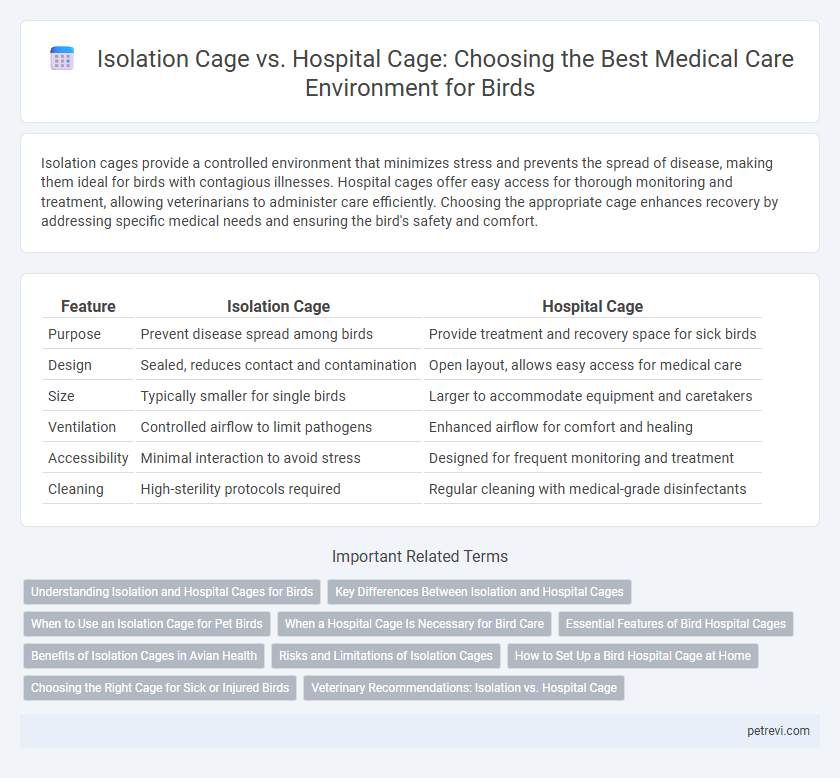Isolation cages provide a controlled environment that minimizes stress and prevents the spread of disease, making them ideal for birds with contagious illnesses. Hospital cages offer easy access for thorough monitoring and treatment, allowing veterinarians to administer care efficiently. Choosing the appropriate cage enhances recovery by addressing specific medical needs and ensuring the bird's safety and comfort.
Table of Comparison
| Feature | Isolation Cage | Hospital Cage |
|---|---|---|
| Purpose | Prevent disease spread among birds | Provide treatment and recovery space for sick birds |
| Design | Sealed, reduces contact and contamination | Open layout, allows easy access for medical care |
| Size | Typically smaller for single birds | Larger to accommodate equipment and caretakers |
| Ventilation | Controlled airflow to limit pathogens | Enhanced airflow for comfort and healing |
| Accessibility | Minimal interaction to avoid stress | Designed for frequent monitoring and treatment |
| Cleaning | High-sterility protocols required | Regular cleaning with medical-grade disinfectants |
Understanding Isolation and Hospital Cages for Birds
Isolation cages for birds are designed to prevent the spread of contagious diseases by providing a separate, controlled environment that limits contact with other birds, while hospital cages focus on offering a comfortable, easily accessible space for ongoing medical treatment and observation. Isolation cages typically feature non-porous materials and enhanced ventilation to reduce pathogen transmission, whereas hospital cages often include perches, feeding stations, and space for medical equipment to support recovery. Understanding the distinct purposes and features of both cages is crucial for effective avian medical care and infection control.
Key Differences Between Isolation and Hospital Cages
Isolation cages for birds are designed to prevent the spread of contagious diseases by physically separating the infected bird from others, featuring secure, often smaller enclosures with easy-to-clean surfaces and individual ventilation systems. Hospital cages prioritize accessibility and comfort to facilitate close monitoring, treatment, and recovery, with adjustable perches, feeding ports, and space for medical equipment. Key differences include purpose-driven design elements: isolation cages emphasize biosecurity and containment, while hospital cages focus on supportive care and ease of medical intervention.
When to Use an Isolation Cage for Pet Birds
Isolation cages are essential for pet birds exhibiting contagious diseases or recovering from infectious conditions to prevent cross-contamination among avian companions. Use an isolation cage when a bird shows symptoms such as respiratory distress, unusual droppings, or behavioral changes indicative of illness. Proper ventilation, easy-to-clean surfaces, and separate food and water dishes are critical features for effective isolation cages in bird medical care.
When a Hospital Cage Is Necessary for Bird Care
Hospital cages are necessary for bird medical care when isolation from other birds is required to prevent the spread of infectious diseases or to provide a controlled environment for intensive treatment. These cages offer enhanced features such as easy sanitation, secure confinement, and controlled temperature and humidity, which are critical for post-surgical recovery and monitoring. Isolation cages are typically simpler and used primarily for short-term separation, whereas hospital cages are specialized units designed for comprehensive medical intervention and support.
Essential Features of Bird Hospital Cages
Bird hospital cages prioritize medical functionality with features like secure closures, non-toxic materials, and easy access for veterinary procedures. These cages often include adjustable perches, transparent walls for monitoring, and controlled ventilation to reduce stress and promote healing. Unlike isolation cages, hospital cages are designed to facilitate treatment while ensuring the bird's safety and comfort during recovery.
Benefits of Isolation Cages in Avian Health
Isolation cages offer significant benefits in avian health by minimizing exposure to pathogens and reducing stress, which supports faster recovery during medical treatment. These cages provide a controlled environment with regulated temperature, humidity, and ventilation tailored to the specific needs of sick birds. Their design also prevents cross-contamination and allows for close monitoring, ensuring optimal hygiene and effective disease management.
Risks and Limitations of Isolation Cages
Isolation cages for bird medical care pose significant risks including increased stress and limited airflow, which can hinder recovery and worsen respiratory conditions. These cages often restrict movement and natural behaviors, potentially leading to muscle atrophy and mental health decline. Hospital cages designed specifically for avian patients provide better ventilation, controlled environments, and space to promote healing while minimizing stress.
How to Set Up a Bird Hospital Cage at Home
Setting up a bird hospital cage at home requires a quiet, well-ventilated space with minimal stress factors to promote healing. Use a clean, appropriately sized cage with soft perches, easy access to fresh water and nutritious food, and gentle lighting to reduce agitation. Separate the bird from other pets and maintain consistent temperature and humidity levels to support recovery during medical care.
Choosing the Right Cage for Sick or Injured Birds
Isolation cages provide a controlled environment that minimizes exposure to pathogens, essential for preventing cross-contamination during the treatment of sick or injured birds. Hospital cages are specifically designed with features like easy access for veterinary care, adequate ventilation, and secure locking mechanisms to ensure bird safety and comfort. Selecting the right cage depends on the bird's medical condition, size, and the need for close monitoring, with isolation cages used for contagious cases and hospital cages for intensive care and recovery.
Veterinary Recommendations: Isolation vs. Hospital Cage
Veterinary recommendations emphasize that isolation cages are essential for contagious or newly admitted birds to prevent disease transmission, while hospital cages provide a controlled environment tailored for intensive medical treatment and close monitoring. Isolation cages prioritize biosecurity with easy-to-clean materials and adequate ventilation to reduce pathogen spread. Hospital cages offer features like adjustable lighting, temperature control, and accessibility to administer medications, facilitating optimal recovery conditions for avian patients.
Isolation Cage vs Hospital Cage for Bird Medical Care Infographic

 petrevi.com
petrevi.com